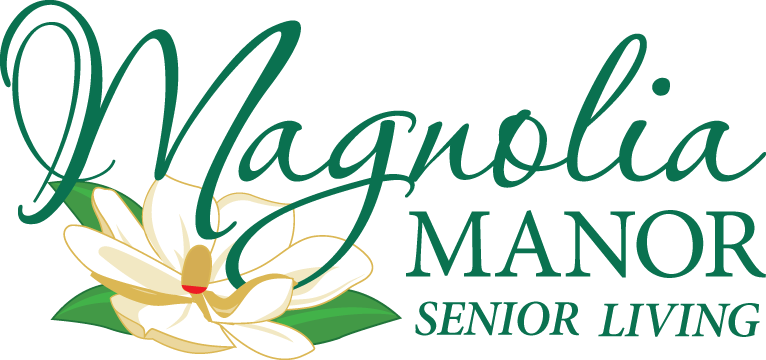Senior Rehabilitaion in Georgia
Don't have time to read this now? Download a PDF version instead.
Senior Rehabilitation Therapy in Georgia
We all want to live life to the fullest, but that can become more difficult as we age. We become more susceptible to strokes, cardiac events, falls, and other accidents. These things and other factors can leave our bodies weaker and impair our ability to perform everyday tasks, to get around effectively, to eat, or even to speak clearly.
Falls are the number 1 cause of injuries to adults 65 or older, including fatal injuries. One of the leading causes of falls is balance problems, which affect about a third of seniors (even more so past age 75). Another major concern is stroke. According to the Centers for Disease Control, 795,000 Americans suffer a stroke each year – and 140,000 of them die. More than half of seniors who survive a stroke are left with impaired mobility.
Thankfully, seniors can take advantage of rehabilitation therapies to restore – or at least improve – their physical and functional capabilities. By the time we reach our senior years, many of us have already experienced first-hand the benefits of physical rehabilitation, thanks to a broken bone, joint injury, or the like. Senior rehabilitation is essentially the same, but often broader in scope due to the more complex health needs of older adults.
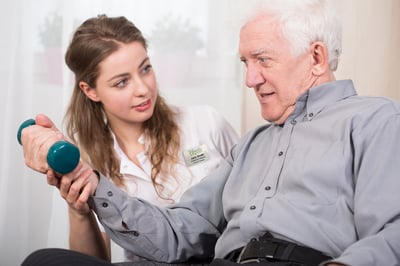 Say your senior Mom or Dad has suffered a serious injury, heart attack, stroke, joint replacement or another type of surgery. They are ready to leave the hospital, but not ready to return home – at least not yet. Senior rehabilitation provides an ideal transition period, in which seniors can continue to recover medically, functionally, and emotionally. The goal is always to restore maximum, if not full, independence.
Say your senior Mom or Dad has suffered a serious injury, heart attack, stroke, joint replacement or another type of surgery. They are ready to leave the hospital, but not ready to return home – at least not yet. Senior rehabilitation provides an ideal transition period, in which seniors can continue to recover medically, functionally, and emotionally. The goal is always to restore maximum, if not full, independence.
Rehabilitation can help seniors who have experienced:
- Orthopedic injury or surgery such as joint replacement or amputation
- Multiple traumatic injuries
- Cardiovascular events such as heart attack or stroke
- Neuromuscular disorders
- Traumatic brain injury or spinal cord injury
- Deteriorating vision
Depending on each person’s specific situation, rehabilitation may include one or a combination of therapies:
- Physical therapy aims to increase strength, flexibility, and function of limbs and joints and to improve balance for standing and mobility. Physical therapy also helps reduce pain.
- Occupational therapy doesn‘t mean your Mom or Dad is expected to return to work. This type of therapy is designed to strengthen fine motor skills and improve other capabilities required to perform the tasks that occupy us daily, such as personal hygiene, dressing, cooking, and writing. Occupational therapy often involves learning to do things differently or to use adaptive equipment.
- Speech therapy assists patients who have difficulty swallowing or speaking clearly, often the result of a stroke or progressive disease such as Alzheimer’s or Parkinson’s. Communication and eating are life-critical! In some patients, speech therapy can also help with cognitive skills such as listening, memory, and problem-solving.
Unlike substance abuse programs – you cannot simply “check yourself in” for senior rehabilitation. You must have a note from your doctor (or the discharging hospital) that verifies your therapy is medically necessary. This officially begins the process of creating a personalized care and treatment plan.
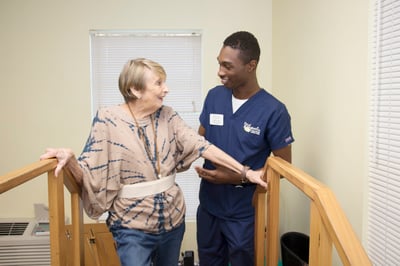 Senior Rehabilitation at Magnolia Manor
Senior Rehabilitation at Magnolia Manor
As a non-profit, faith-based organization, Magnolia Manor serves seniors in eight communities throughout Georgia. Among our campuses, we offer all types of senior living, from fully independent to assisted living, memory care, skilled nursing and rehabilitation services. Each campus is unique in its own ways, but the one thing that never varies is our absolute dedication to providing exceptional, personalized care in a family-like environment.
At Magnolia Manor, four of our eight campuses feature onsite rehabilitation centers:
- Americus
- Buena Vista
- Columbus
- Midway

All four of our rehabilitation centers serve residents of that particular Magnolia Manor campus. We also treat patients from the surrounding community. These patients are not necessarily seniors, they may be as young as 20-something. But they come to us for essentially the same reason – to recover strength and mobility following surgery, an accident, or some other type of injury. Non-residents may receive therapy either as outpatients or as short-term inpatients.
Each campus has a different layout. At Americus, for example, our new Rehab Center is separate from our skilled nursing facility, but they are connected by a hallway. This makes it easier for our skilled nursing staff to serve inpatient rehab patients as well. Our rehabilitation therapists are available to serve all residents when necessary.
Short-term inpatient services are provided for those who have been hospitalized but who need more time and assistance to recover before going home on their own. On average, our patients stay about 33-34 days as inpatients. For outpatients, a typical regimen may involve 2 to 3 sessions per week for 4 weeks.
.jpg?width=400&name=Americus%20Rehab%20Therpay%20(9668).jpg) Non-resident rehab patients are usually referred directly to us by the hospital/doctor which is discharging them. However, we also see patients (both seniors and younger) who were discharged to go home only to find they cannot manage on their own after all. Our care team evaluates each person according to their doctor’s orders, then develops an appropriate weekly inpatient or outpatient therapy schedule.
Non-resident rehab patients are usually referred directly to us by the hospital/doctor which is discharging them. However, we also see patients (both seniors and younger) who were discharged to go home only to find they cannot manage on their own after all. Our care team evaluates each person according to their doctor’s orders, then develops an appropriate weekly inpatient or outpatient therapy schedule.
As a faith-based organization, we offer pastoral care as well as therapy and skilled nursing services as needed for each patient. Our ecumenical outreach includes all faiths and is always available to anyone who desires the extra comfort that pastoral care can bring.
Because rehabilitation is often required by seniors. Knowing what to expect ahead of time can also be a tremendous comfort for both seniors and their families. In this guide, we will explain when and why rehabilitation is prescribed. The different types of rehab services and settings. What it’s like to be a rehab patient, what rehabilitation costs, and how to choose a rehab center that will help your loved one feel comforted in mind and spirit while their body is recovering physical strength and functionality.

Knowing When Senior Rehab is Necessary
Almost everyone, regardless of age, needs some extra help when they first return home from a hospital stay or immediately following a serious accident or injury. If help is available, your Mom or Dad may be able to return home immediately. However, you can’t be there all the time, and the need to travel to and from outpatient therapy twice a day, several times a week, can wear on everyone after a while.
Rehabilitative therapy is not something you can handle yourself. It takes a trained therapist to know how exactly to work with each individual, to help them recover appropriately,y and to accurately assess their progress. You may be able to hire in-home health care services, but the cost can surpass the cost of inpatient or outpatient rehabilitation. And with COVID-19 restrictions, in-home therapist visits are not so widely available.
A hospital discharge planner will consult with you regarding your loved one’s need for rehabilitation and the expected length of their stay, if inpatient care is indicated. Making the right decision now can speed recovery, minimize overall cost, and help avoid future hospitalization.
Not Every Senior Is Excited to Go to Rehab
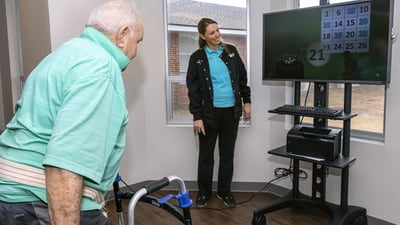 It’s one thing to understand intellectually that you aren’t ready to function on your own quite yet, but this can be difficult to accept emotionally. For many seniors the thought of rehab seems like a step toward a “lesser” life – especially for those who don’t know what rehab entails. You can help calm concerns by:
It’s one thing to understand intellectually that you aren’t ready to function on your own quite yet, but this can be difficult to accept emotionally. For many seniors the thought of rehab seems like a step toward a “lesser” life – especially for those who don’t know what rehab entails. You can help calm concerns by:
- Avoiding the old-fashioned term “nursing home,” since it has negative connotations for older generations in particular. Using positive terms such as rehabilitation, recuperation, and recovery can help encourage compliance, if not outright enthusiasm. Emphasizing that rehab is meant to be temporary can also help motivate them. Your loved one isn’t there to stay, they are there to get stronger so they can go home sooner and healthier.
- Explaining why they need rehabilitation, what it can realistically do to help them, and the possible ramifications of foregoing treatment. For example, we know that the vast majority of fractures, especially hip fractures, are caused by falls. Without rehab, more than half of seniors will fall again within six months. However, getting proper rehabilitative treatment increases a senior’s chance to return to independent living by 80 percent.
- Uncovering any non-medical factors that are making your loved one balk. Are they worried about who will care for their home or pets while they’re away? Are they worried about mounting costs? Addressing these fears can make your senior more comfortable heading into rehab and help them stay positively focused on recuperating while there.
- Including Mom or Dad in decision-making about their discharge plan and choosing a rehab center. The more informed and engaged they are, the more they will “own” the process and be motivated to participate fully in their own recovery.
- Asking your pastor to speak with Mom or Dad. No matter how much you love your parents and have their best interests at heart, sometimes a trusted third party can be more soothing and persuasive, especially someone who knows Mom personally, understands her spiritual needs, and is a well-trained listener.
Successful rehabilitation is a team effort involving medical professionals, therapists and other caregivers. Before new patients join us, we hold a care plan meeting that includes family members to ensure everyone understands the doctor’s orders as well as what rehabilitation is really all about.
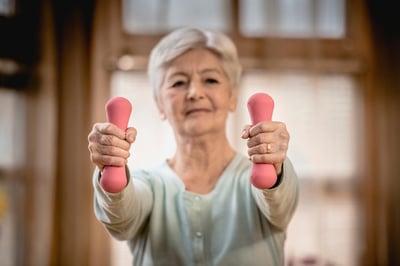 Prior to COVID-19, we often conducted in-home assessments so patients (and families) could see their actual capabilities in their actual living environment. This was helpful because often seniors aren’t entirely forthcoming about increasing problems they may be having with daily living. In addition, it gave our therapist a chance to see what the patient would face after returning home – stairs, or narrow hallways, for example.
Prior to COVID-19, we often conducted in-home assessments so patients (and families) could see their actual capabilities in their actual living environment. This was helpful because often seniors aren’t entirely forthcoming about increasing problems they may be having with daily living. In addition, it gave our therapist a chance to see what the patient would face after returning home – stairs, or narrow hallways, for example.
All this information enabled us to jump-start their treatment and assure that the care plan was designed to address specific at-home realities. Since we cannot do these at-home assessments now, we try to delve as deeply as possible into each patient’s “discharge reality” when we hold our care plan meeting and in follow-up conversations as we track rehab progress.
While we want every patient to return to their “before” lifestyle, we know some will not be able to do that. Knowing up front allows families and seniors to immediately begin planning their transition to a different type of living environment, even as rehab is proceeding. Infrequently, as rehab gets underway, our team determines that the go-home plan we created will not succeed as we had hoped. In this case, we can start discussing an alternative discharge plan.
Every senior (and their loved ones) should take heart, knowing that time spent in rehab is the best possible prescription for a healthy, well-functioning future. Short-term pain for a longer-term gain, you might say.
Types of Senior Rehabilitation Facilities
Unlike other types of senior living, rehabilitation is never meant to be a “lifestyle.” It may be short-term or long-term, but by its very nature, it is not a permanent situation. Senior rehabilitation is intended to be a supportive environment in which to regain strength and self-confidence – an opportunity to recover as much strength and functionality as possible.
Rehabilitation is a highly individualized process, based on each person’s medical health status as well as physical and functional status and prognosis for improvement. Depending on the type(s) of therapy needed and the patient’s overall health, rehab can be performed in three different settings:
At home
Sometimes, rehab therapy can be provided at a patient’s home, though this option may not be workable to most seniors and their families. That’s especially true now, given the distancing recommendations related to COVID-19. At-home treatment is limited to equipment the therapist can transport with them or the traits of the home itself (stairs, the kitchen, a car to get in and out of, etc.) that can be used to practice certain movements. At-home therapy can also cost more in the long run than either outpatient or inpatient rehab.
However, if “home” is an assisted living community, residents can usually receive outpatient rehab treatment in the community’s gym or activity center.
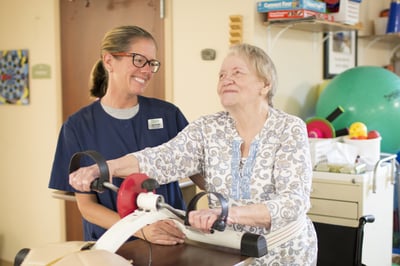 Seniors who normally live independently but who need some assistance with activities of daily living immediately following hospitalization may be able to move into an assisted living community on a temporary basis. Not all assisted living communities allow this, but it could be worth looking into as a short-term respite solution to accommodate both daily living and rehab needs. This can also serve as a “trial run” if Mom or Dad is not able to return to fully independent living, even after rehabilitation.
Seniors who normally live independently but who need some assistance with activities of daily living immediately following hospitalization may be able to move into an assisted living community on a temporary basis. Not all assisted living communities allow this, but it could be worth looking into as a short-term respite solution to accommodate both daily living and rehab needs. This can also serve as a “trial run” if Mom or Dad is not able to return to fully independent living, even after rehabilitation.
Outpatient
In this case, the patient is well enough to go home to reside following hospitalization or a serious injury or accident, and they can get around well enough to travel to a rehabilitation clinic to receive physical, occupational, and/or speech therapy treatments. Although facilities vary, outpatient clinics and inpatient rehab facilities both typically offer a wide range of advanced equipment and supplies to help personalize treatment and achieve the most effective results.
Inpatient
Inpatient rehabilitation enables patients to stay in a skilled nursing facility or hospital, where they can receive housing, 24/7 monitoring, and whatever care they need in addition to the required rehabilitation services, all in one location. As temporary full-time residents, patients also receive daily meals and may participate in a variety of activities outside their therapy sessions, often including counseling. Patients wear their own clothes and are free to move about as they are able. Assistance with activities of daily living are provided, if needed. Rooms are usually semi-private, although some facilities do offer private rooms.
A potential risk with both in-home and outpatient therapy is that the patient may be disinclined to practice therapeutic movements once the therapist is gone. This can prolong recovery or reduce its beneficial effects. Inpatient residents are provided with varied opportunities outside their therapy sessions to stay engaged and active in ways that further their recuperation.
Inpatient rehabilitation may be short-term or long-term. The shortest stay possible is always the goal, but how long rehab takes depends on the individual and their overall health. It can take much longer to recover functionality lost to a significant stroke or heart attack than to restore function after an injury or surgery.

Senior Rehabilitation at Magnolia Manor
We provide physical, occupational, and speech therapy at our rehab centers, along with aqua therapy at our Americus center. In addition, our assisted living facilities each include a therapy gym where therapists can work with those residents as outpatients when necessary.
In 2019, we invested in a major expansion of rehab facilities at our Americus campus. Following the completion of a brand new Mattie H. Marshall Center for Memory Care, we were able to transform the previous space into a state-of-the-art rehabilitation center, featuring many types of specialized equipment: .jpg?width=400&height=601&name=Americus%20Rehab%20Therapy%20(482).jpg)
- Solo-Step Track and Harness system, a state-of-the-art apparatus that assists patients who have walking or balance issues due to a stroke or an amputation for example. The harness supports the patient, so it eliminates the fear of falling as they work to improve standing tolerance and mobility. Equipment like this is typically only seen in outpatient therapy clinics, but we are a pioneer among rehab centers in Georgia, in adopting this cutting-edge technology.
- Omnicycle, a bike that works the upper extremities and lower extremities to build strength and endurance.
- Omni-VR, a virtual video game that works on standing tolerance, balance, sequencing, cognition, and hand/eye coordination.
- Pacer gait trainer for stroke/spinal cord/ amputee/orthopedic gait training.
- Standing frame, to increase standing tolerance, dynamic balance, and cardiac recovery (orthostatic hypertension).
- Estim machine, which aids in neurological re-education, pain management, and wound care.
- Ultrasound machine for swelling and pain management.
- Mock kitchen, where our short-term patients can practice making meals, cleaning dishes, etc.
- Steps for stair training.
Some of our therapists at Americus are certified in dementia care, so they are able to serve residents of our Mattie H. Marshall Center, too. The fact is, your Mom may not remember her therapy session, but her body will still benefit. Therapy for dementia patients is similar but often modified to better engage the person in improving their physical function.
For example, if your Mama loved to knit, then some simple knitting or similar recognizable movements might be employed. Or, if she was always especially proud of her spotless home, we might use ankle weights and encourage her to “scrub the floor” with her feet. For least disruption, we work with memory care patients in the activity room of their residential facility rather than bringing them to the rehab center.
A Typical Day in Senior Rehab
Every day is personally tailored in senior rehabilitation, so the details of your Dad’s day will be different in some ways than for others. Nonetheless, there is a pattern we follow in scheduling, to ensure every short-term resident gets the most from every minute they spend with us. Here’s what a “typical” day might look like:
- Morning brings a nutritious, tasty breakfast (we have fabulous chefs at Magnolia Manor) and a visit from a staff member to check in with each patient as needed. If Dad needs medical care or assistance getting ready for his day, we’re there for him. Then it’s off to rehab, with a treatment regimen developed just for Dad. Our inpatients usually “work” two sessions a day, 2-2.5 hours in the morning and again in the afternoon, 5 or 6 days a week.
- Midday is a time for another delicious meal to keep the body fueled, plus time to relax muscles that have worked hard during the morning.
- Afternoon means back to work, with another rehab workout.
- And then there’s dinner, yet another chance to indulge in culinary delights – a much-appreciated side benefit of inpatient rehab at Magnolia Manor.
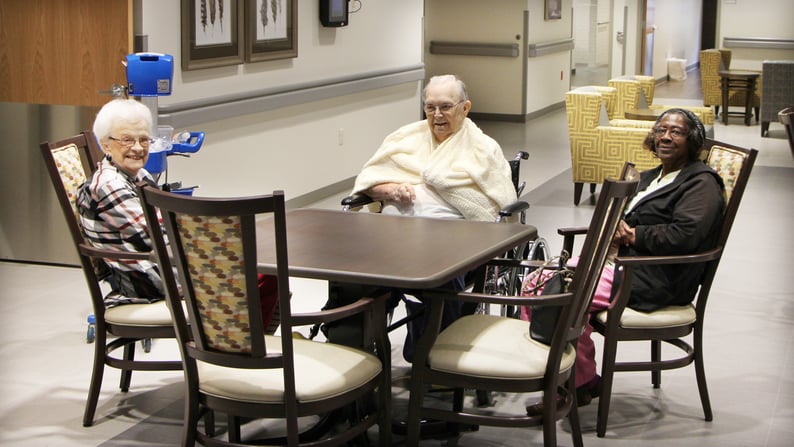
But Dad isn’t just sitting around when he’s not eating or rehabbing. We offer bingo, art, puzzles – all sorts of activities and entertainment designed to keep the mind stimulated and the muscles moving. And if Dad just wants to kick back and read or watch TV, we encourage that, too, because downtime helps the body prepare for the next day’s therapy sessions. COVID-19 limitations now restrict group interactions, of course, but we do everything we can to make things homey and as “normal” as possible for all our Magnolia Manor residents.
Holistic Approach
Attitude can exert a powerful impact on a senior’s ability to recover. At Magnolia manor, we believe – we know – that caring for the spirit is just as important as caring for the body and the mind. Our holistic approach to senior living extends to our rehabilitation centers as well as throughout our permanent residential communities.
What If More Care Is Needed?
Sometimes, sadly, rehab cannot fully restore a patient to their status before their stroke, heart attack, or accident. When this happens, those who were living independently will be healthier and safer in an assisted living setting. Less often, a patient who now has ongoing medical challenges will need to transition from assisted living to memory care or full time skilled nursing.
Although you hope this won’t apply to your beloved Mom or Dad, it is important to be aware of the possibility, especially since most memory care and skilled nursing facilities have waiting lists. Having a Plan B in mind ahead of time can give you greater peace of mind and more options.
Among our eight Magnolia Manor senior living campuses, we offer rehabilitation services at Americus, Buena Vista, Columbus, and Midway. If a resident’s Magnolia Manor campus does not offer rehabilitation services onsite, we refer them to one of our other campuses that does have a rehabilitation center. If they don’t want to move to another Magnolia Manor campus, we refer them to one of the other providers in the area of their choice.
If your loved one will not be able to recover sufficiently to return to independent living, even with in-home help, assisted living or maybe even skilled nursing will be required. All of our rehab centers are associated with a skilled nursing facility, so it is possible to transition to full time skilled nursing care without moving to another campus.
.jpg?width=400&height=267&name=Americus%20Rehab%20Therpay%20(9659).jpg)
At our Columbus community, we offer both rehab and assisted living, so a transition could be made without leaving the community. (We also offer assisted living at Macon, Moultrie, Richmond Hill, and St. Marys.) Although we do have waiting lists for some facilities, we give preference to current residents who need to transfer to a different type of living accommodation.
Occasionally, staff working with rehab patients detect that the person is also suffering from early (or not-so-early) signs of Alzheimer’s or another type of dementia. This will affect post-rehab care options, so it is something you will want to discuss in detail with your loved one’s care team. Should your parent’s doctor recommend professional memory care, Magnolia Manor communities at Americus, Buena Vista, and Columbus include specialized memory care facilities.
Before COVID-19, we encouraged family members to stay involved with their loved one in rehab, including joining them during their sessions. This was a great incentive for our seniors and a morale-booster for families as well. Now, we can’t do that, so we use Facetime instead. Seniors can communicate virtually, even during therapy, which helps everyone feel as involved and connected as possible.
Cost of Senior Rehabilitation
According to Senior Living, the average cost of care in a skilled nursing facility is $245 per day ($7,441 per month, or $89,297 per year) for a semi-private room or $275 per day ($8,365 per month, or $100,275 per year) for a private room. That’s nationwide. Here in Georgia, the average monthly cost for a semi-private room is $6,342.
Costs continue to increase, more dramatically in some locations than others. By 2028, Senior Living predicts the national average cost for a semi-private room will have risen to $120,008. Fortunately, Georgia has one of the country’s lowest rates of increase.
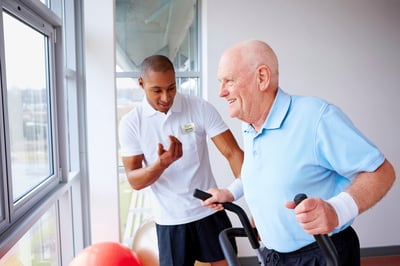 Do not assume you cannot afford senior rehabilitation at Magnolia Manor. We take great pride in the outstanding quality of our staff and the friendly, personalized care we give every patient, but we also work hard to make our communities affordable. Every senior’s financial situation is different, so we encourage you to talk with us one-on-one about cost and any other concerns. Our goal is to help seniors live life to the fullest, and rehab can contribute greatly to that, especially when you feel good about your choice of rehab center!
Do not assume you cannot afford senior rehabilitation at Magnolia Manor. We take great pride in the outstanding quality of our staff and the friendly, personalized care we give every patient, but we also work hard to make our communities affordable. Every senior’s financial situation is different, so we encourage you to talk with us one-on-one about cost and any other concerns. Our goal is to help seniors live life to the fullest, and rehab can contribute greatly to that, especially when you feel good about your choice of rehab center!
We would love to meet with you in person and give you a tour, but COVID-19 has made that impossible for now. Nonetheless, we are always happy to speak via phone or video conference.
Paying For Senior Rehab
Medicare Part A provides hospital insurance, so it covers rehabilitation therapy within a hospital setting. Medicare also covers up to 100 days of inpatient rehab in a skilled nursing facility or rehabilitation center – providing you have been hospitalized at least 3 days leading up to rehab.
To clarify, Medicare will pay 100% of the cost for the first 20 days, then patients must share the cost for the remaining 80 (or fewer) days. This is per benefit period, which starts when you enter the hospital and ends when you have gone 60 days without hospitalization or skilled nursing care. Once Medicare has paid for 100 days of rehabilitation, coverage ends.
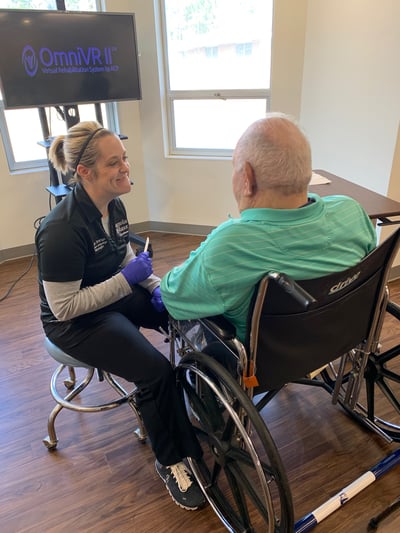 However, if the patient becomes hospitalized again later, a new benefit period begins and rehab coverage will be available once again, with the same limitations as before. Medicare does not limit the number of benefit periods available to patients.
However, if the patient becomes hospitalized again later, a new benefit period begins and rehab coverage will be available once again, with the same limitations as before. Medicare does not limit the number of benefit periods available to patients.
Medicare covers costs for:
- Physical, occupational, and speech therapy
- Semi-private room (private rooms only if medically necessary)
- Meals
- Nursing services
- Medications
- Other hospital supplies and services
Doctor’s services you receive while an inpatient in a rehab center are covered under Medicare Part B (medical coverage).
There is an important caveat at work here: Medicare coverage is available only as long as the patient continues to make progress toward their rehabilitation goal. If Mom or Dad is not improving, coverage will be discontinued on the theory that some other type of treatment plan would be more effective.
The need to pay personally for part of rehab therapy after the first 20 days can be another motivating factor for many seniors – the faster they recover enough to return home, the more money they can save, even if they need to continue rehab as an outpatient.
Another important financial consideration is the fact that refusal to undergo rehab when ordered by a doctor after a 3-day (or longer) hospital stay automatically cancels rehab coverage under Medicare or Medicaid. Should Mom or Dad decide later that rehab was necessary after all, they will have to spend another minimum 3 days in the hospital in order to qualify for renewed rehabilitation coverage. If a patient enters rehab but leaves early against medical advice, this can also negatively affect future Medicare or Medicaid coverage.
If Mom can move temporarily into an assisted living community while she’s receiving rehab therapy, Medicare will cover the cost of the therapy (not the living accommodations), just as it would if she were back at home.
Medicaid is a federal program, but it is administered individually by each state. Although states can set their own rules, federal law requires all states to cover medically necessary nursing home care or home health services, including rehabilitation. Medicaid is available only to seniors who meet the income and other eligibility requirements.
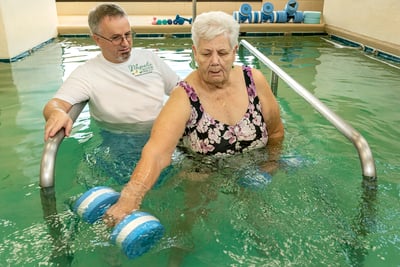 Private Pay
Private Pay
If your loved one has a Medicare Advantage plan or some type of private insurance, that may help cover rehabilitation costs beyond 20 days. Nonetheless, patients typically choose to go home as soon as possible once their out-of-pocket expense kicks in.
Private health insurance may cover short-term rehabilitation care, in a hospital or in-home or as an inpatient or outpatient at a skilled nursing facility. However, it is essential to check your policy, because coverage varies widely. Private insurance does not cover long-term care.
On the other hand, patients who have specialized long-term care insurance can expect their rehabilitation to be covered. Again, though, policies can differ considerably. If you plan on using private insurance to help cover the cost of Mom’s inpatient or outpatient rehab therapy, be sure to check with your provider first to be sure you understand the coverage details and to confirm the rehabilitation center or clinic is in-network.
On a happy note, skilled nursing costs can be tax-deductible under certain circumstances. It pays to consult your tax advisor to learn more about this.
One resource we highly recommend is our own Affordable Senior Living Guide. It explains all the financial resources potentially available to help pay for senior living at different care levels.
Financial stress won’t help your parent recuperate or help you keep their spirits up. And, if it turns out they will require a change in living accommodations following their stay in rehab, knowing your financial as well as residential options will help you make the best possible choices.
How to Choose a Senior Rehabilitation Facility
Finding the right rehabilitation option for your senior will not be as complicated as researching and choosing permanent senior living accommodations. That said, the range and quality of services offered by rehabilitation centers can vary considerably, so you’ll want to do your homework. Your Mom’s doctor or the discharging hospital may have a recommendation, in which case you should ask why they recommend that particular facility. (The hospital itself may even have a rehab wing.)
Regardless, it’s up to you and your loved one to choose whatever facility you want. Concentrate on rehab options that specialize in treating seniors. Knowing your parent will need rehab, you can also:
- Talk with your friends, neighbors, or church members who have older loved ones to get referrals.
- Ask if your local senior center has a list of rehab centers in the area.
- Look online for facilities nearby.
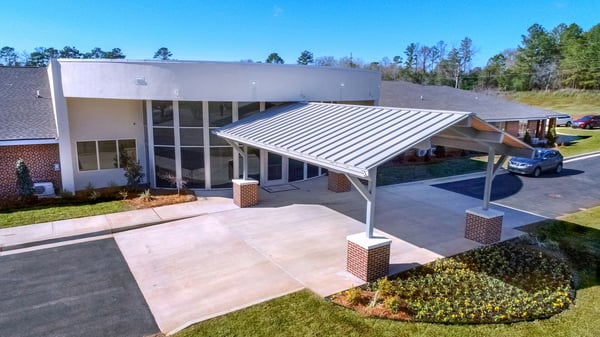 And, of course, if Mom or Dad currently resides in a senior living setting that offers multiple types of care, such as our Magnolia Manor campuses, you will want to learn if they have an onsite rehab center. That could make decision-making fast and easy.
And, of course, if Mom or Dad currently resides in a senior living setting that offers multiple types of care, such as our Magnolia Manor campuses, you will want to learn if they have an onsite rehab center. That could make decision-making fast and easy.
Make a List of Questions
You will certainly have questions, and writing them down will ensure you don’t forget. Ask about:
- Types of therapies offered and equipment and tools available to therapists and patients
- Track record (success rate) – the percentage of senior patients who are able to return home following rehab rather than having to move to a more assistive environment
- Staffing – are there counselors or psychologists available as well as nurses, therapists and other caregivers? Who will be part of your loved one’s care team?
- Staff qualifications and any specialized training/certifications for working with dementia patients, etc.
- Patient/staff ratio
- Experience working with seniors who have the same needs/condition as your parent
- Frequency and duration of therapy sessions
- What activities are available to patients outside scheduled therapy sessions
- Average length of stay
- Communication – how and how often will you receive updates on your loved one’s progress or possible problems with their rehab process? How does the facility define progress?
- Their discharge procedures (how will you know your loved one is not being kept around unnecessarily)
- How can you stay in touch, mindful of distancing requirements now in place?
.jpg?width=400&height=266&name=Americus%20Rehab%20Therpay%20(9632).jpg) See for Yourself
See for Yourself
If a personal visit isn’t feasible, ask to see photos or videos of the rehab center – the therapy facilities, especially. But if Mom or Dad will be an inpatient, check out any visuals you can find of the skilled nursing facility, too, including patient rooms, meals, non-therapy activities, etc.
As you look into potential rehabilitation centers for your loved one (while hoping they will never need one), keep in mind that sometimes rehab cannot accomplish hoped-for results. Choosing a rehab center that is part of a community that offers a broader spectrum of care can ease a post-rehab transition from independent to assisted living or from assisted living to memory care to long-term skilled nursing. Many of our Magnolia Manor residents first experienced the exceptional care and surroundings offered in our communities as a short-term rehab inpatient or outpatient.
What Sets Magnolia Manor Apart
Attitude is everything -- yours and your loved one’s. Losing independence is something we all fear, so it can be truly discouraging, even frightening, to realize your capabilities aren’t what they used to be. Therefore the prospect of rehabilitation should offer tremendous positive motivation for your loved one. Getting their input in making decisions about rehab will help ease fears and focus attention on the positives.
How can you help, especially when you can’t be there in person to share their rehab experience or even to visit? You can be your Mom or Dad’s biggest cheerleader. We talked earlier about ways to focus on the positives, especially the temporary aspect of rehab. If full recovery won’t be possible and Mom is looking at a change in her living situation, focus on how that will help her remain as independent as possible, thanks to the extra care and assistance she will be receiving.
Faith is an important part of healing. The mind, body, and spirit are interconnected and seniors, especially, have to be strong in all these areas. Our will to recover affects our willingness to do the work required as we go through the physical, occupational, and/or speech therapy treatment process.
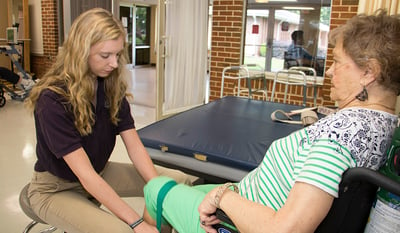 One of the most positive things you can do for your senior Mom or Dad is help them stay strong and healthy. That way they have the best chance of avoiding falls and other mishaps that commonly cause accidents and injuries leading to the need for rehabilitation.
One of the most positive things you can do for your senior Mom or Dad is help them stay strong and healthy. That way they have the best chance of avoiding falls and other mishaps that commonly cause accidents and injuries leading to the need for rehabilitation.
- Staying active keeps the heart, bones, and muscles strong and helps prevent balance problems.
- Eating a healthy diet helps prevent cardiovascular problems, strokes, diabetes, and other conditions that can lead to the need for rehab or reduce its effectiveness.
- Visiting their primary care provider regularly ensures your parent is getting consistent preventive care and assures early detection of any emerging health issues.
Do rest assured that we have gone above and beyond from Day 1 of the pandemic, enacting stringent protocols to ensure everyone associated with our communities remains safe and healthy. These added protections will remain in place as long as necessary, part of our “new normal.”
COVID-19 notwithstanding, the atmosphere within our Magnolia Manor rehabilitation centers and their associated communities is simply different from what you are likely to find elsewhere.
- Patients of all faiths (or no particular religious faith) can feel spiritually uplifted as they heal.
- Compassionate and homey surroundings provide a family-like sense of belonging and comfort.
We believe these factors are critical, because comfort and confidence play major roles in rehabilitation success.
Conclusion
Rehab is no vacation, it is hard work. It can be uncomfortable, even painful. But it’s not boot camp, and our staff is not composed of mean, grumpy drill sergeants. At Magnolia Manor, we’re nice. And friendly. We treat every one of our patients like family. Medical professionals, therapists, caregivers, and the rest of our staff -- we are all here to help your loved one recover to the fullest extent possible.
And, frankly, we hope they leave as soon as possible. But while they’re here, you can expect VIP treatment because that’s what we’d give our own Mom or Dad.
We are guided by our faith and our desire to help every senior live life to the fullest, to their best ability. We know you still might have questions, even after reading through this guide. We’re here with answers whenever you want to talk. To learn more, call us at 1-855-540-LIFE (5433).
